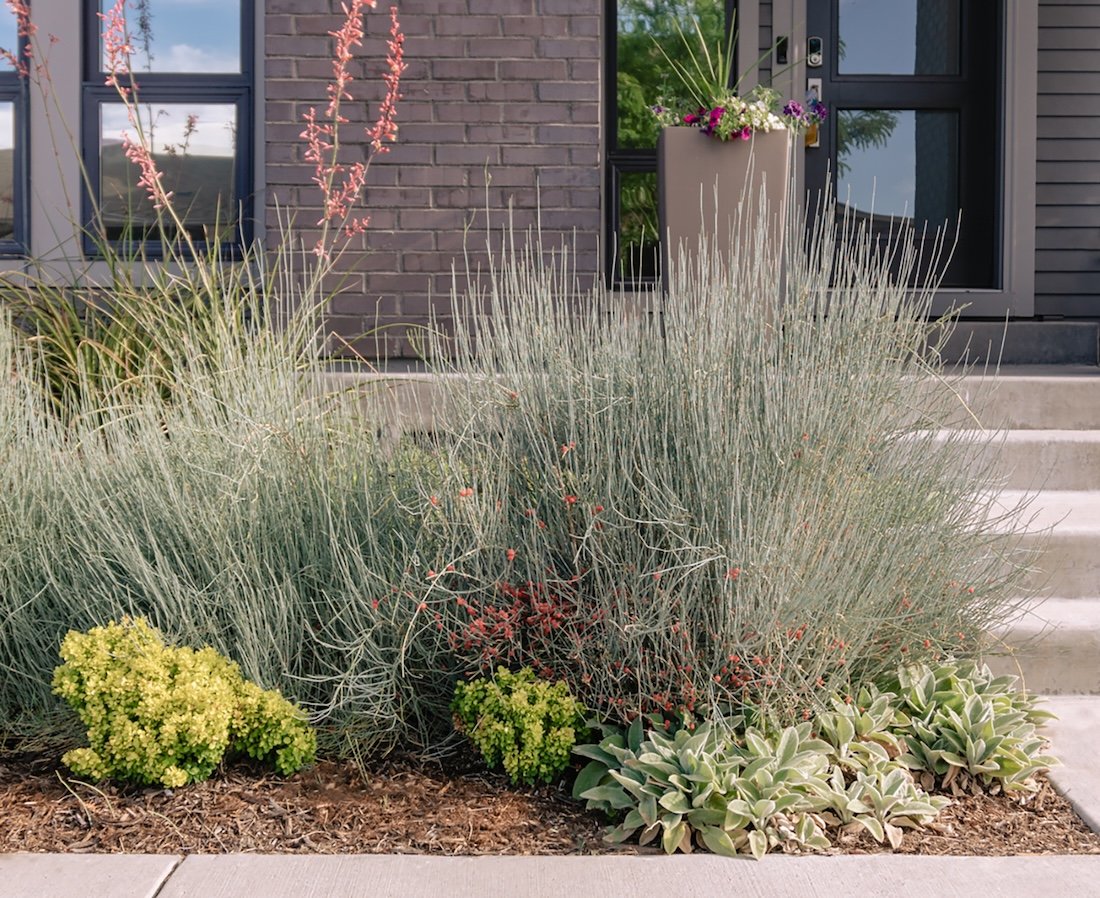What is Xeriscaping?
March 14 , 2025 . Jill Livingston
Twenty-five years ago, when I met with potential landscape design clients, I would mention the word “Xeriscape” and people would look at me like I had two heads – seriously! They would then proceed to nervously tell me they didn’t want a bunch of rock and cacti.
Fast forward to the present – good news, there are many more people who have at least heard of Xeriscaping. It has become more popular, particularly in areas like Colorado, where drought and water restrictions are common. So, what exactly is Xeriscape?
Xeriscaping – Style or Approach?
Most importantly, please know that Xeriscaping is not a design style. It also does NOT mean “Zero” landscaping or a sea of rock. I’m proud to mention that the term originated in Denver, Colorado, my home city, in 1981. The Denver Water Department took the word “Xeri,” originating from the Greek word “xeros,” meaning “dry” and combined it with landscape.
It’s an approach that uses low-water plants. One can do an Internet search and find it described as a style, but in my professional opinion it’s an approach, or guiding principle, NOT a design style. I think it’s very important to differentiate because any “style” of garden or landscape can use low water requiring plants. Throughout the years I’ve designed and installed many Xeric landscapes – their styles ranging from Xeric Victorian to Xeric Mid-Century Modern. If one thinks of it as a style versus an approach, they might be resistant to consider the numerous benefits of Xeriscaping!
Principles of Xeriscaping
My design approach has always been to work with nature, rather than controlling it. In all my years of designing landscapes I’ve yet to meet a client, even the most avid gardener, who asks for a higher maintenance landscape. Xeriscaping is more than just saving water – it’s about creating a sustainable, low-maintenance landscape that also looks amazing!
Design & Planning
Every great space starts with a well-planned design. The goal is to create a landscape that’s as efficient as it is beautiful. To do this:
Evaluate the space: Look at sun exposure, slopes, and shade to determine which areas need more or less water.
Group plants wisely: Place plants with similar water needs together. This is called "hydro zoning" and helps prevent overwatering in certain areas.
Hardscape elements: Incorporate paths, sitting areas, rocks, and other alternative surfaces to reduce the need for traditional turf grass.
Plan for drainage: Ensure that water doesn't pool in unplanned areas by grading slopes, adding permeable paving, and/or re-routing drainage from downspouts.
2. Soil Improvement
Healthy soil is the foundation of all thriving landscapes, and Xeriscaping is no exception. The right soil helps plants absorb water, nutrients, and oxygen effectively. Soil can always be amended for improvement. After planting, we often give our landscape installations an extra healthy start by applying an organic blend fertilizer, specifically tailored for Colorado’s growing challenges. No matter your location – healthy soil is the key for a water-efficient and successful Xeriscape!
3. Efficient Irrigation
Overwatering not only wastes resources, but it can suffocate drought-resistant plants. The right irrigation system makes a huge difference:
Drip irrigation: This system delivers water directly to the roots, minimizing waste from evaporation or runoff.
Pop-up Spray Heads: If you prefer pop-up spray heads, switch fixed spray nozzles to rotary nozzles. These nozzles are much more water efficient as they release larger, heavier droplets of water compared to a fine mist that is more prone to evaporation and susceptible to wind disruption. Important: the timer should be set longer for Rotary nozzles.
Time wisely: Water early in the morning or late in the evening to reduce evaporation. In Denver, water before 10:00 am or after 6:00 pm.
Irrigation doesn’t need to be complicated, but it should be intentional. With a well-designed irrigation system, you can significantly lower your water bill and keep plants healthy all at the same time.
4. Native and Drought-Resistant Plants
One of the most important steps in Xeriscaping is selecting plant species and varieties suited to your climate. It reduces maintenance and ensures a thriving landscape! To help with your plant selection, focus on:
Native plants: These are already adapted to your area’s climate and need less attention. They also support and attract local wildlife like birds and pollinators. Some of my Colorado design favorites are Amorpha and Ephedra – both extremely hardy shrubs.
Drought-resistant plants: Look for resilient options like succulents (e.g., Delosperma and Sedums), grey-leafed perennials (e.g., Artemisia, Lavandula, and Marrubium), and ornamental grasses that thrive with less water. For plant guidance in Colorado, I highly recommend referring to Plant Select. Just click on the big green box that says, “Search right plant right place.” It’s a great resource that I often share with my clients and students.
Layered planting: Use the full plant palette! Combine groundcovers, perennials, vines, shrubs, and trees (deciduous and evergreen) to create a dynamic oasis that retains moisture and blocks harsh sunlight.
The most important key to success is working with your environment, not against it! When done thoughtfully, a Xeriscape can provide numerous benefits for you and the greater community.



